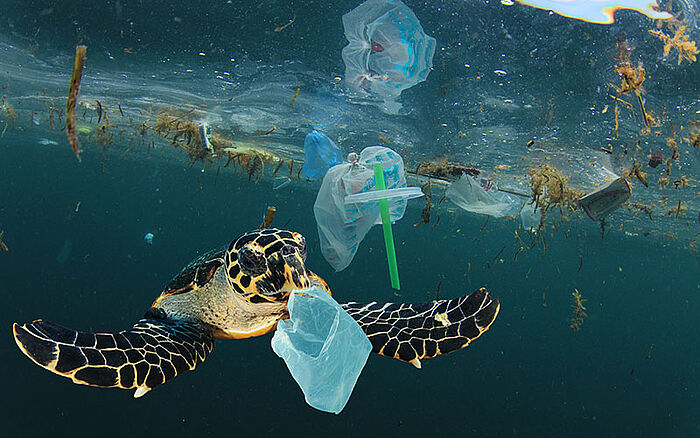
How patents can drive sustainability
Sustainability is rightly at the top of corporate and political agendas worldwide. In November 2022, the latest United Nations Climate Change Conference ("COP27") took place in Sharm El-Sheikh, Egypt. This international gathering marked the 30th anniversary of the adoption of the United Nations Framework Convention on Climate Change. As Egyptian president Abdel Fattah El-Sisi asserted on the conference website: "In the thirty years since, the world has come a long way in the fight against climate change and its negative impacts on our planet; we are now able to better understand the science behind climate change, better assess its impacts, and better develop tools to address its causes and consequences."
Innovation has a vital role in the fight against climate change, and new technologies will be essential in the move to "net zero." This function was recognized at last year's COP26 in Glasgow, where 40 members signed the so-called Glasgow Breakthroughs, setting targets to accelerate the deployment of clean technologies in power generation, road transport, steel, hydrogen and agriculture. The summary decision alone mentioned "technology" no fewer than 10 times.
The Intellectual Property (IP) system can support this push toward greener processes by incentivizing the development and commercialization of innovative technologies. Many sustainable inventions, such as alternative fuels, involve significant up-front investment and a degree of commercial risk. To this situation, patents bring legal certainty, providing a competitive advantage and a tool for fundraising. Other forms of IP, such as trademarks, designs and trade secrets, also have their part to play in these ventures. However, the scale of the environmental challenge is such that we need to carefully consider the function of the IP system as a whole and how it can prop up sustainable innovation. This includes ensuring that IP rights are accessible, patent information is freely available and technology transfer is as smooth as possible.
Trends in sustainable innovation
The European Commission has set out ambitious targets to build a climate-neutral Europe, not least in the Sustainable Europe Investment Plan in 2020 and the European Green Deal, which became legally binding in 2021. Both of these agreements defined commitments that all businesses in Europe must adhere to. As lofty as the goals are, there is already good progress to boost confidence. The latest edition of the joint European Patent Office (EPO) and European Union Intellectual Property Office (EUIPO) report on IPR-intensive industries and economic performance in the European Union, published in October 2022, dedicates a chapter to "Climate Change Mitigation Technologies" (CCMT) and green EU trademarks.
Even given the relative newness of these European initiatives, the report notes that according to recent estimates, revenues for environmental technologies and resource efficiency are expected to grow to nearly €10 trillion by 2030 (an annual growth rate of 7.3%). According to the report, CCMT-related patent applications filed at the EPO by European applicants have grown from around 2,000 in 2001 to some 6,500 in 2019. Filings are led by applicants from Germany, followed by France, the Netherlands, Denmark and Sweden. In Denmark, where the overall number of patent filings is lower, applications for sustainable inventions represent an impressive 18.5% of the total originating from Danish companies. The report also found that more industries are filing CCMT-related patent applications, ushered by the manufacture of batteries and accumulators, mining of other non-ferrous metal ores, electricity production, electricity transmission and repair and maintenance of aircraft and spacecraft. The contribution of patent- and trademark-intensive companies to employment and GDP has also increased.

According to the EPO-EUIPO study, CCMT patent- and green trademark-intensive industries accounted for 9.3% of total employment in the EU from 2017–2019. Meanwhile, these sectors contributed 14% of the EU's GDP during the same period, demonstrating the high productivity of sustainable innovation.
In October 2022, the United Kingdom Intellectual Property Office (UK IPO) published a series of mini reports on seven technology areas linked to the government's plan for a "Green Industrial Revolution" (offshore wind; low-carbon hydrogen; nuclear power; environmentally friendly transportation; heat pumps; carbon capture, usage and storage and flood and coastal defense). The reports confirmed that the number of patents being filed worldwide in green technology fields has "significantly increased" over the past 20 years. In particular:
- Wind power has displayed a 300% increase in worldwide patenting activity over the last 10 years.
- Patents for low-carbon hydrogen have more than doubled worldwide over the past decade.
- Worldwide patenting activity in greener vehicles has increased by over 300% in the past 10 years.
- Patenting of heat pumps has increased by more than 200% in the past five years.
- Patenting activity for carbon capture and storage worldwide has more than doubled over the past decade.
- Flood and coastal defense patents have seen increases of over 250% in the past 10 years.
First steps into green fields
While the upward trends in patent filings relating to green technologies are welcome, more can be done to promote the benefits of IP protections to companies working in relevant sectors. This drive is all the more pressing since much of this sustainable innovation takes place in organizations that do not take full advantage of the patent system. In some cases, patents may even be viewed as a barrier to the uptake of technologies. Moreover, the importance of tackling climate change and the strong feelings this objective inspires may discourage some researchers from engaging with the patent system. Therefore, initiatives to promote awareness of the patent system at a high level are crucial. In 2020, for example, the theme for World Intellectual Property Day (April 26) was "Innovation for a Green Future," and the World Intellectual Property Organization (WIPO) published a range of articles, including a special edition of its magazine, highlighting how IP rights can promote sustainable technology.
Making searching and filing easier
On a more granular level, there are also steps to increase the accessibility of the patent system for inventors of sustainable technologies. For instance, the EPO's so-called Y tags (Y02 for CCMT and Y04S for "Smart Grids") in the Cooperative Patent Classification (CPC) system are regularly updated and provide a user-friendly way to search for relevant documents. As reviewing prior art can be as daunting as it can be time-consuming, it is essential to allow innovators to be able to search patent databases quickly and accurately.
Another EPO initiative is the CodeFest on Green Plastic, taking place from 2022-23. This imaginative competition aims to help make the know-how contained in patents concerning green plastics more readily available to innovators. Additionally, it hopes to inspire future research and development that supports healthy ecosystems and drives the circular economy for environmentally friendly plastics.

UNESCO estimates that eight to 10 million metric tons of plastic find their way into the ocean every year, adding to the 50-75 trillion pieces of plastic and microplastics currently polluting the world's water.
Some IP offices also offer procedural benefits to sustainable technologies. For example, since 2009, the UK IPO has offered a Green Channel for accelerating the grant proceedings of patent applications where the invention holds an environmental benefit. The Office publishes a list of Green Channel publications (over 3,000 so far). To be eligible, applicants must indicate how their invention helps the environment and which actions (e.g., search, examination) they wish to accelerate. There is no additional fee for using the Green Channel.
In a similar scheme, the United States Patent and Trademark Office (USPTO) announced a Climate Change Mitigation Pilot Program earlier this year. Qualifying non-provisional patent applications involving technologies that alleviate climate change will be fast-tracked for examination up until a first action on the merits. Launching the program, Under Secretary of Commerce for Intellectual Property and Director of the USPTO Kathi Vidal said: "This is part of our ongoing efforts to incentivize innovation — including in key technology areas like climate change — and maximizing that innovation's widespread impact by reducing greenhouse gas emissions." The pilot will last until June 5, 2023, or until 1,000 petitions have been accepted. Other patent offices providing accelerated or expedited examination programs include those of Japan, Australia, Israel and Canada.
The China National Intellectual Property Administration (CNIPA) also proposes a priority patent examination program for energy conservation, environmental protection, new energies, vehicles and smart manufacturing technologies. And last but not least, the EPO allows applicants to file requests for accelerated search and examination at no additional cost under the PACE program, whether or not the patent application relates to green technologies. Initiatives such as these demonstrate that the patent system can provide the flexibility needed to advance green technology implementation. Given the success of the existing IP office schemes and the widespread sense of urgency, similar programs will probably be developed in the future.

Properly wielded, the patent system can deliver incentives and fast tracks to sustainable innovations. However, the current trend of expedited procedures must avoid becoming a victim of its own success in unintentionally encouraging applications for products falsely labeled as green.
But for such systems to be effective, they need to be communicated and well-understood by inventors and businesses. That means that everyone involved in the IP ecosystem – IP offices, researchers, patent attorneys and IP service providers – needs to understand the opportunities available and explain them to patent applicants.
Promoting licensing
Another promising area of green progress is the promotion of sustainable technology licensing. Many inventions of this kind have the potential to be used in diverse sectors. Consequently, patent proprietors may need support to fully realize the potential of their inventions and the commercial benefits they are due, particularly if they are individual entrepreneurs or startups. Established in 2013, WIPO GREEN promises a partial solution to this problem. It endeavors to connect seekers and providers of environmentally friendly technologies with a database of patents as well as networking and acceleration projects.
To give a couple of examples, the online platform recently hosted a "Women in GREEN" series and a climate change impact survey. WIPO GREEN also celebrates success stories of sustainable innovators around the world to motivate, inspire and champion the development of pivotal new technologies. Its current figures exceed 120,000 listed inventions, needs and experts, 130 partners, 2,000 users and 1,000 facilitated connections worldwide. Effective licensing can unlock the potential of patents, speed up further progress and expedite the rollout of innovative products to consumers. Given the seriousness of tackling climate change, we must do as much as possible to facilitate sustainable licensing.
Overcoming challenges – now and in the future
Sustainable technology faces some particular difficulties when it comes to gaining IP protection. For a start, these inventions often span different sectors, meaning they can be challenging to classify and search. There may also be specific questions about exceptions to patentability in certain jurisdictions, specifically with regard to biotechnology or computer programs. Many sustainable innovations produce incremental improvements or use software and artificial intelligence to make existing products and processes more efficient. In these cases, and many others, advice should be sought from a qualified patent attorney as to what aspects of the invention are likely to be patentable, the state of the prior art and how applications should be drafted to achieve the most extensive protection.

During substantive examination, claims made in applications are closely scrutinized for novelty, non-obviousness / inventive step and industrial applicability. Thus, as much attention to detail must be paid to the patent drafting process as to the creative one to avoid rejection or third-party opposition.
Even when patents are not obtainable, other IP rights can still have a role to play. Take some design features that make a vehicle more aerodynamic: These may not be eligible for a patent grant but may be protected by registered design rights or copyrights. Trademarks, including certification marks, offer guarantees to consumers regarding quality and origin and build brand loyalty.
As we have seen, there are challenges surrounding sustainable technologies' commercialization. While some innovations will have specific, obvious uses, others will likely have much broader applications. Expert advice on the most appropriate strategies should always be requested beforehand, and again with a view to raising financing, preparing non-exclusive licensing agreements for platform technologies and / or negotiating an exclusive licensing contract with a trusted partner.
Given the scale and severity of the climate crisis, the initiatives and opportunities provided by IP offices and organizations around the world signal that the next few years will be crucial to ensuring that the IP system is doing all it can to support sustainable and green innovation. In that regard, patents will play a pivotal role in helping to limit global warming and its knock-on effects.
A version of this article was first published in The Patent Lawyer Magazine, Annual 2023.
Filed in

Exploring an alternate 2025 where patents are made weaker by design to encourage sustainable innovation.



